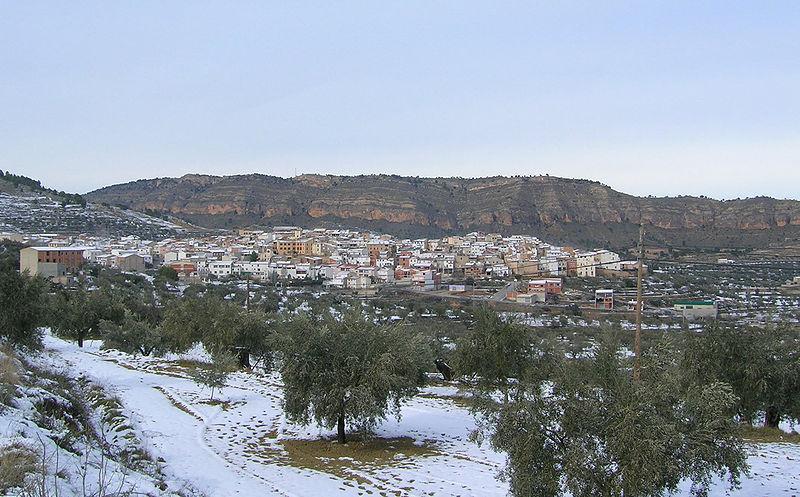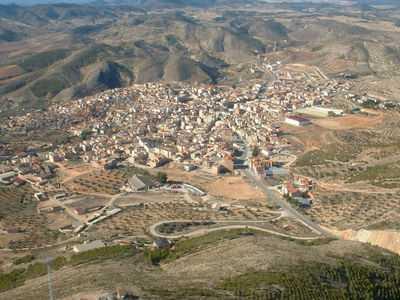Albacete, Castilla-La Mancha, Spain
Suggest Place to Visit
1368
Track to location with GPS |
 |
Many interesting things could be written about Elche de la Sierra, taking into account its past. A beautiful story of a working people where its leaders always proposed, together with the progress of the people, ´´the right aim of helping the poor and avoiding laziness´´.
(ELCH., April 1, 1807 - Parish Archives).
´´ ... Due to the lack of historical knowledge of rustic people, they believe that Elche was Elchocico, because its first settlers lived in huts; nonsense that deserves the laughter of the literati. Well know ... that Elche was a respectable town in Roman times, this is combined by the ruins of buildings found in the same garden of Elche, its castle, the tombstones with inscriptions and a multitude of coins that are found ... According to history, Elche corresponds to Ilici Batillsano that Colomeo placed in his geographical tables near the Villares, which today exist with the same name. All concepts that have deserved to be received as historical axioms by the Academy of Sages of Italy and by the scholar Abate Masdeu, author of the Critical History of Spain´´.
Francisco de la Parra (April 1, 1807).
ENEOLITHIC:
(Chalcolithic)
Places: Cuevas Blancas and Loma del Mojón.
Elche de la Sierra enters Prehistory hand in hand with the sedentarization that occurred during the Chalcolithic period belonging to the Eneolithic era. At this time, man substitutes his nomadic and hunter lifestyle for which he alternates hunting and herding with agriculture. While the habitat continues in the caves, there is an emergence of open-air settlements, already begun in the late Neolithic, there are clear testimonies of the manufacture of tools carved in flint as evidenced by the tools found in Cuevas Blancas and Loma del Cairn.
BRONZE AGE:
End of the 2nd millennium BC. 1st Quarter of the millennium BC.
Caves are abandoned in favor of surface villages. It is located in a head of easy defense and it seems to be confirmed some lines of wall. The economic base is agricultural and livestock, although mining and metallurgy begins to develop. The funeral rite is burial.
IBERIAN:
Mid IV BC - I A.C.
Place: La Peña.
It is a culture formed on a strong indigenous substratum on which orientalizing and Mediterranean stimuli would act brought by Etruscans, Phoenicians, Punics and Greeks who arrived on the peninsula at the dawn of the 1st millennium BC. Agriculture is much more complex, appearing a trade orientation. The towns are constituted in places of easy defense, due to their bellicose character. The lathe is used for the first time for the construction of ceramic tools. These were decorated with geometric, zoomorphic and anthropomorphic figures of red paint. Bronze tools are replaced by iron ones.
E. OLD:
(Colonizations) 229 - 228 B.C.
Place: Villares (Elche de la Sierra).
Amílcar Barca, General - Chief of the Carthaginians in Spain, dies fighting the Batistanos. Amílcar Barca drowned in a river. ´´Polibio: Universal History, II, I, 5 - 6´´. He died in Helice that many authors identify with Elche de la Sierra. ´´Historia Universal (Editorial Gredos), History of Spain (Editorial Espasa - Calpe, S.A.
ROMANIZATION: II BC to V D.C.
Place: Villares and Vicorto.
In the second century, this part of Hispania was already subdued, although its native population did not become extinct and, therefore, its customs. The typical Iberian settlement, together with ceramics and Roman construction techniques, support the previous statement. The presence of the Roman population determined a profound change regarding the system of exploitation of the land, the town, etc.
May 22, 1,213:
(Vespers of the Assumption of the Lord).
Alfonso VIII, in union with the Archbishop of Toledo D. Rodrigo Ximénez de Rada, conquers the city of Alcaraz. Elche de la Sierra, like Peñas de San Pedro, Bogarra, Villapalacios, Bienservida, Villaverde, Villarrobledo, Riópar and Ayna, became Alcaraz villages.
1,242:
Pelayo Pérez, Master of Santiago, in the company of the Portuguese Gil Gómez Do Vinhal, conquers the castles of Vicorto and Villares.
May 31, 1,243:
Gil Gómez Vinhal resigns in Murcia to his castles of Híjar, Vicorto, Gutta (Villares) and Abejuela in favor of the Order of Santiago in exchange for the commission of Paracuellos.
End of June 1,457:
The infidels "ran" or looted the lands of Elche, Ayna, Bogarra, Paterna and Riópar.
1,562:
Elche, together with the villages of Ayna and Morote, requests the privilege of Villazgo.
September 22, 1,565:
In the site and forest of Segovia, King Felipe II grants Ayna the privilege of Villazgo. It is constituted as an independent Municipality and Elche as a village of Ayna. In total (Elche included) the municipality of Ayna had 2,225 inhabitants and an area of 14,603 hectares.
June 1, 1,570:
Inauguration of the 1st Church of Elche, located on the same site as the current one and which was destroyed in 1783.
1,590:
The Parish Archive begins. From this date it has been kept complete
January 20, 1,783:
Laying of the 1st stone of the current Church.
1,788:
Completion of the current Church.
May 1,793:
Elche is constituted, ecclesiastically, Independent Parish of Ayna. Elche had 500 families and 200 more neighbors than Ayna. (Elche had about 2,000 inhabitants).
May 31, 1829:
By virtue of the Royal Orders, the Royal Chancery of Granada judicially divides the Royal and Municipal Mayors of the future province of Albacete. Elche de la Sierra is the Royal Mayor's Office.
1,834:
Elche becomes independent from Ayna. Independent City Council is constituted. He understood the current term of Molinicos.
November 20, 1838:
The primitive municipal term of Elche de la Sierra is expanded:
- With the Dehesa de Torre Pedro, which was from Alcaraz.
- With Peñarrubia, who was from Yeste, Peñarrubia then had 32 neighbors.
- With Villares (called Villar de Gutta) and with Campillo and Vicorto who were from Letur.
The Sierra del Segura Tourism Association was created in February 1995 as a non-profit entity with only 5 companies.
The region is made up of 12 municipalities: Ayna, Bogarra, Elche de la Sierra, Férez, Letur, Liétor, Molinicos, Nerpio, Paterna del Madera, Riópar, Socovos and Yeste.
Today, the associated tourist offer is made up of: 371 associated establishments and 129 businessmen.
We have: 3,151 hotel accommodation places, 1,700 campsites and 1,600 restaurant places in the region (concentrated around the towns of Riópar and Yeste).
The Sierra del Segura receives approximately 300,000 visitors and tourists annually, a respectable figure in the region as a whole.
The Sierra del Segura Association works daily to defend the interests of the tourism sector in the area. Thanks to this work, we have become - within rural tourism - the strongest professional association at the county, provincial and even regional level.
“Enjoy its Fishing Reserve, its Hunting Reserve, its descent down the Segura River and its Hiking Routes
Church of Santa Quiteria: this great neoclassical building built in the eighties of the eighteenth century was projected by the architect Francisco Pérez Rodríguez on the previous church and sixteen more houses that had to be demolished. The single plant has 1,350 square meters of extension. Its structure is Jesuit with a Latin cross plan, side chapels (covered by domes) joined together and a flat head. The temple has two towers on the façade and the neoclassical style altarpiece that it conserves represents the martyrdom of Santa Quiteria.
Town Hall: located in Plaza Ramón y Cajal, the Town Hall was built at the beginning of the 19th century. It is built by two bodies and openings with semicircular arches.
Paseo and Parque de La Concordia: the Paseo is the main recreational place for the residents of the town where you can enjoy lush shadows thanks to the centenary planted plane trees. In this place the weekly market takes place every Thursday, the start of the popular race ´´Vuelta a la Peña San Blas´´ in early February and the stalls of the September fair. In the vicinity of the Paseo is the Cristo Crucificado school in which an ancient holm oak known as ´´La Carrasca´´ is located. This oak has a rope of more than 4.60 meters and reaches an age of more than 700 years. La Concordia Park, inaugurated in 1986, is a botanical garden where you can see numerous native species and species from other areas.
The surroundings of the town are full of many sources (El Alamillo, Fuente Hilario, La Poza, Fuente Carrasca ...) and beautiful natural landscapes, especially the canyons of the Segura River in areas such as El Almazarán, La Longuera, Gallego or El Barranco Andrés. In all of them you can enjoy a bath in the crystal clear waters of the Segura River.
Comments
We don´t have yet any comments about:
Elche de la Sierra
Elche de la Sierra
Be the first to leave a comment as it is very important to inform other people
Outros locais a visitar
Within a radius of 20 km from:Elche de la Sierra
Férez |
| 10,0 Km |
 |
Hotel reservation near Elche de la Sierra within a radius of 20 km
Why to book with RUTAS TURISTICAS
The best prices
Our partnerships with the world´s largest operators offer research on the best market prices.
More options
At Rotas Turisticos you can book the hotel, buy the air ticket, book the transfer from the airport to the hotel and vice versa, book the local excursions, rent the car, take travel insurance and consult the places to visit and where to go.
Holiday Tips & Destinations
Hundreds of holiday destinations with all the options that allow you to easily choose the destination that best suits your dream vacation.
RUTAS TURISTICAS
Links






